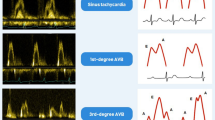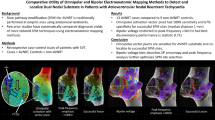Abstract
Ventricular tachycardia associated with prior myocardial infarction account for significant morbidity, mortality, and health care costs despite the favorable outcomes shown by ICD clinical trials. Catheter ablation has been increasingly used as an adjunctive therapy in the management of scar-related ventricular tachycardia. Novel technologies have facilitated the outcomes of current ablation strategies. Three-dimensional mapping systems have allowed identification of the scar substrate, its critical sites in the tachycardia circuit, and selection of ablation sites based on fairly precise electroanatomic substrate.







Similar content being viewed by others
References
Newby, K. H., Thompson, T., Stebbins, A., Topol, E. J., & Califf, R. M. (1998). Sustained ventricular arrhythmias in patients receiving thrombolytic therapy: incidence and outcomes. The GUSTO Investigators. Circulation, 98(23), 2567–2573.
Moss, A. J., Zareba, W., Hall, W. J., Klein, H., Wilber, D. J., Cannom, D. S., et al. (2002). Multicenter automatic defibrillator implantation trial II Investigators. Prophylactic implantation of a defibrillator in patients with myocardial infarction and reduced ejection fraction. New England Journal of Medicine, 346(12), 877–883.
Kim, Y. H., Sosa-Suarez, G., Trouton, T. G., O'Nunain, S. S., Osswald, S., McGovern, B. A., et al. (1994). Treatment of ventricular tachycardia by transcatheter radiofrequency ablation in patients with ischemic heart disease. Circulation, 89(3), 1094–1102.
Rothman, S. A., Hsia, H. H., Cossu, S. F., Chmielewski, I. L., Buxton, A. E., & Miller, J. M. (1997). Radiofrequency catheter ablation of postinfarction ventricular tachycardia: long-term success and the significance of inducible nonclinical arrhythmias. Circulation, 96(10), 3499–3508.
El-Shalakany, A., Hadjis, T., Papageorgiou, P., Monahan, K., Epstein, L., & Josephson, M. E. (1999). Entrainment/mapping criteria for the prediction of termination of ventricular tachycardia by single radiofrequency lesion in patients with coronary artery disease. Circulation, 99(17), 2283–2289.
Arenal, A., del Castillo, S., Gonzalez-Torrecilla, E., Atienza, F., Ortiz, M., Jimenez, J., et al. (2004). Tachycardia-related channel in the scar tissue in patients with sustained monomorphic ventricular tachycardias: influence of the voltage scar definition. Circulation, 110(17), 2568–2574.
Marchlinski, F. E., Callans, D. J., Gottlieb, C. D., & Zado, E. (2000). Linear ablation lesions for control of unmappable ventricular tachycardia in patients with ischemic and nonischemic cardiomyopathy. Circulation, 101(11), 1288–1296.
Marchlinski, F., Garcia, F., Siadatan, A., Sauer, W., Beldner, S., Zado, E., et al. (2005). Ventricular tachycardia/ventricular fibrillation ablation in the setting of ischemic heart disease. Journal of Cardiovascular Electrophysiology, 16(Suppl 1), S59–S70.
Stevenson, W. G., Khan, H., Sager, P., Saxon, L. A., Middlekauff, H. R., Natterson, P. D., et al. (1993). Identification of reentry circuit sites during catheter mapping and radiofrequency ablation of ventricular tachycardia late after myocardial infarction. Circulation, 88(4 Pt 1), 1647–1670.
Stevenson, W. G., Friedman, P. L., Sager, P. T., Saxon, L. A., Kocovic, D., Harada, T., et al. (1997). Exploring postinfarction reentrant ventricular tachycardia with entrainment mapping. Journal of the American College of Cardiology, 29(6), 1180–1189.
Soejima, K., Stevenson, W. G., Maisel, W. H., Sapp, J. L., & Epstein, L. M. (2002). Electrically unexcitable scar mapping based on pacing threshold for identification of the reentry circuit isthmus: feasibility for guiding ventricular tachycardia ablation. Circulation, 106(13), 1678–1683.
Wilber, D. J., Kopp, D. E., Glascock, D. N., Kinder, C. A., & Kall, J. G. (1995). Catheter ablation of the mitral isthmus for ventricular tachycardia associated with inferior infarction. Circulation, 92(12), 3481–3489.
Berruezo, A., Mont, L., Nava, S., Chueca, E., Bartholomay, E., & Brugada, J. (2004). Electrocardiographic recognition of the epicardial origin of ventricular tachycardias. Circulation, 109(15), 1842–1847.
Swarup, V., Morton, J. B., Arruda, M., & Wilber, D. J. (2002). Ablation of epicardial macroreentrant ventricular tachycardia associated with idiopathic nonischemic dilated cardiomyopathy by a percutaneous transthoracic approach. Journal of Cardiovascular Electrophysiology, 13(11), 1164–1168.
Sosa, E., & Scanavacca, M. (2005). Epicardial mapping and ablation techniques to control ventricular tachycardia. Journal of Cardiovascular Electrophysiology, 16(4), 449–452.
Sosa, E., Scanavacca, M., d'Avila, A., Oliveira, F., & Ramires, J. A. (2000). Nonsurgical transthoracic epicardial catheter ablation to treat recurrent ventricular tachycardia occurring late after myocardial infarction. Journal of the American College of Cardiology, 35(6), 1442–1449.
Della Bella, P., Pappalardo, A., Riva, S., Tondo, C., & Fassini, G. (2002). Trevisi Non-contact mapping to guide catheter ablation of untolerated ventricular tachycardia. European Heart Journal, 23(9), 742–752.
Soejima, K., Delacretaz, E., Suzuki, M., Brunckhorst, C. B., Maisel, W. H., Friedman, P. L., et al. (2001). Saline-cooled versus standard radiofrequency catheter ablation for infarct-related ventricular tachycardias. Circulation, 103(14), 1858–1862.
Cummings, J. E., Pacifico, A., Drago, J. L., Kilicaslan, F., & Natale, A. (2005). Alternative energy sources for the ablation of arrhythmias. Pacing and Clinical Electrophysiology, 28(5), 434–443.
Erdogan, A., Grumbrecht, S., Neumann, T., Neuzner, J., & Pitschner, H. F. (2003). Microwave, irrigated, pulsed, or conventional radiofrequency energy source: which energy source for which catheter ablation? Pacing and Clinical Electrophysiology, 26(1 Pt 2), 504–506.
Skanes, A. C., Klein, G. J., Krahn, A. D., & Yee, R. (2003). Advances in energy delivery. Coronary Artery Disease, 14(1), 15–23.
Natale, A., Pisano, E., Shewchik, J., Bash, D., Fanelli, R., Potenza, D., et al. (2000). First human experience with pulmonary vein isolation using a through-the-balloon circumferential ultrasound ablation system for recurrent atrial fibrillation. Circulation, 102(16), 1879–1882.
Wang, J. A., Sun, Y., & He, H. (2003). Ultrasound ablation of pulmonary veins for treatment of paroxysmal atrial fibrillation. Zhejiang Univ Sci, 4(6), 745–748.
Meininger, G. R., Calkins, H., Lickfett, L., Lopath, P., Fjield, T., Pacheco, R., et al. (2003). Solomon SB.Initial experience with a novel focused ultrasound ablation system for ring ablation outside the pulmonary vein. J Interv Card Electrophysiol, 8(2), 141–148.
Khairy, P., Chauvet, P., Lehmann, J., Lambert, J., Macle, L., Tanguay, J. F., et al. (2003). Lower incidence of thrombus formation with cryoenergy versus radiofrequency catheter ablation. Circulation, 107(15), 2045–2050.
Pfeiffer, D., Moosdorf, R., Svenson, R. H., Littmann, L., Grimm, W., Kirchhoff, P. G., et al. (1996). Epicardial neodymium YAG laser photocoagulation of ventricular tachycardia without ventriculotomy in patients after myocardial infarction. Circulation, 94(12), 3221–3225.
Saksena, S., Gielchinsky, I., & Tullo, N. G. (1989). Argon laser ablation of malignant ventricular tachycardia associated with coronary artery disease. American Journal of Cardiology, 64(19), 1298–1304.
VanderBrink, B. A., Gilbride, C., Aronovitz, M. J., Lenihan, T., Schorn, G., Taylor, K., et al. (2000). Safety and efficacy of a steerable temperature monitoring microwave catheter system for ventricular myocardial ablation. Journal of Cardiovascular Electrophysiology, 11(3), 305–310.
Knaut, M., Tugtekin, S. M., Spitzer, S., & Gulielmos, V. (2002). Combined atrial fibrillation and mitral valve surgery using microwave technology. Seminars in Thoracic and Cardiovascular Surgery, 14(3), 226–231.
Lickfett, L., & Calkins, H. (2002). Catheter ablation for cardiac arrhythmias. Minerva Cardioangiologica, 50, 189–207.
Author information
Authors and Affiliations
Corresponding author
Rights and permissions
About this article
Cite this article
Arruda, M., Fahmy, T., Armaganijan, L. et al. Endocardial and epicardial mapping and catheter ablation of post myocardial infarction ventricular tachycardia. J Interv Card Electrophysiol 28, 137–145 (2010). https://doi.org/10.1007/s10840-010-9469-5
Received:
Accepted:
Published:
Issue Date:
DOI: https://doi.org/10.1007/s10840-010-9469-5




